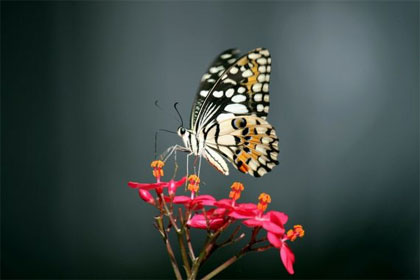
Borg Worms Share Their Memories While Killer Butterflies Cannibalize Their Own Caterpillars
Paul Seaburn September 13, 2021
Science fiction scribes battling writer’s block often turn to the world of science non-fiction for ideas. If you’re one of them, today is your lucky day. Researchers in the world of gut microbes have discovered that some intestinal worms have a kind of Borg collective that they use to share memories, while a team of insect scientists were shocked to witness cannibalistic butterflies drinking the liquid insides of caterpillars – dead or alive. Movie producers – get ready for a flood of scripts.
“C. elegans protects itself from pathogens by “reading” bacterial small RNAs, using this information to both induce avoidance and transmit memories for four generations. Here, we found that memories can be transferred from either lysed animals or from conditioned media to naive animals via Cer1 retrotransposon-encoded virus-like particles.”
 Borg worms? Tell us more!
Borg worms? Tell us more!
In a study published in the journal Cell and reviewed in a press release, researchers from Princeton University’s Murphy Lab watched as microscopic gut nematodes Caenorhabditis elegans consumed the bacterium Pseudomonas aeruginosa – which causes food poisoning in both humans and C. elegans – absorbed a strand of non-coding RNA called P11 which bound to a sensory gene called maco-1 which, should it survive, taught it to avoid P. aeruginosa in the future. It then passed that memory to the next four generations of its descendants the normal way, but surprisingly also shared this memory with other worms when it died – as they came in contact with the remains, they absorbed the memory and suddenly began avoiding P. aeruginosa. What other memories might these Borg worms be sharing? Sound like we’ll have to wait for the movie or novel for an answer.
Meanwhile, in the world of butterflies …
“Scientists have discovered that milkweed butterflies harass, subdue, and subsequently feed on live, dead, and dying caterpillars belonging to other milkweed butterflies – that is, their family’s young.”
“These chemicals also help male butterflies produce mating pheromones, which function as nuptial ‘gifts’ to females during courtship … in the forests of North Sulawesi, Indonesia, it appears that they have developed a taste for caterpillars – all in their quest to increase their supplies of this love drug, the researchers posit.”
“The behaviour does not fit neatly in the traditional modes of predation, parasitism, or mutualism, and so presents a new challenge to evolutionary theory. We have coined it ‘kleptopharmacophagy’ – chemical theft for consumption.”
Sex-crazed male milkweed butterflies in Indonesia have been observed drinking the liquid insides of the caterpillars hatched from their own eggs – dead and sometimes alive – in order to produce a butterfly equivalent of flowers and candy to entice female milkweed butterflies to have sex with them … and start this horrific (and movie-worthy) process all over again. Lead author of the study, published in the Ecological Society of America journal Ecology, PhD candidate Mr Yi-Kai (Kai) Tea from the University of Sydney School of Life and Environmental Sciences explains in a sci-fi-worthy yet eerily real press release (with photos) the gruesome process the deceptively pretty-looking male milkweed butterflies use to get ready for a date.
 While related to the killer Indonesian milkweed butterflies, North American monarchs do not share their cannibalistic mating practices
While related to the killer Indonesian milkweed butterflies, North American monarchs do not share their cannibalistic mating practices
“Caterpillars are essentially bags of macerated leaves; the same leaves that contain these potent chemicals the milkweed butterflies seek out. To adult butterflies, they may simply be an alternative source of chemicals on which to feed.”
“The caterpillar larvae would contort their bodies rapidly in what appeared to be futile attempts to deter the scratching.”
That’s right … the butterflies scratch their own caterpillars with sharp tarsal claws, then insert their long curly tongues into the oozing wound to lap up the pheromonal juices to take to their potential one-minute-stand. Do they kill their own caterpillars with this scratching? Tea and his team weren’t sure, so that’s up to the novelist or screenwriter penning “Attack of the Killer Cannibal Butterflies.”
Both of these real scientific discoveries would make great movie or book plots, wouldn’t they? And of course, Bags of Macerated Leaves would be a great name for a band.
MU*





















